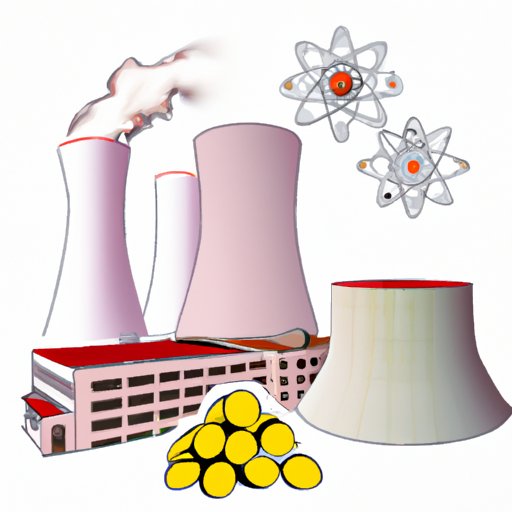Introduction
A nuclear power plant is a facility that uses nuclear fission to generate electricity. Nuclear power plants use uranium or plutonium fuel rods to produce heat, which is then used to create steam that drives a turbine to generate electricity. In this article, we will explore the various costs associated with building and operating a nuclear power plant.

Analyzing the Cost of Nuclear Power Plants: Breaking Down Construction and Operation Expenses
Building a nuclear power plant is an expensive endeavor. The initial construction expenses can vary significantly depending on the size and complexity of the power plant, the type of reactor being used, the location of the power plant, and other factors. According to the World Nuclear Association, the cost of constructing a nuclear power plant can range anywhere from $3 billion to $10 billion. In addition to the cost of construction, there are also ongoing operation costs associated with running a nuclear power plant, such as personnel and maintenance costs.

Examining the Financial Implications of Building a Nuclear Power Plant
When considering the cost of building a nuclear power plant, it is important to consider the potential risks associated with the project. The cost of building a nuclear power plant can be unpredictable due to the complexity of the project, the risk of delays, and the potential for unexpected costs. It is also important to consider the financing options available when building a nuclear power plant, as these can have a significant impact on the overall cost.
Comparing the Costs of Nuclear Power Plants to Other Energy Sources
When comparing the cost of nuclear power plants to other energy sources, it is important to consider both the cost benefits and the environmental impacts of each source. Nuclear power plants are often seen as more cost-effective than other sources of energy, such as coal or natural gas, but they also come with a higher risk of accidents and require more stringent safety regulations. On the other hand, renewable energy sources, such as wind and solar, are becoming increasingly affordable, although their intermittent nature makes them less reliable than nuclear power.

Investigating the Cost of Nuclear Fuel and Waste Disposal for Nuclear Power Plants
In addition to the cost of building and operating a nuclear power plant, it is also important to consider the cost of nuclear fuel and waste disposal. Nuclear fuel is a major expense for nuclear power plants, as uranium and plutonium must be purchased on the open market. Additionally, the cost of disposing of nuclear waste must also be taken into account, as this can be a significant expense.

Assessing the Overall Cost of Nuclear Power Plants in Different Countries
The cost of building and operating a nuclear power plant can vary significantly from country to country. Factors such as the regulatory environment, labor costs, and access to technology can all influence the cost of a nuclear power plant in different countries. Additionally, the cost of nuclear fuel and waste disposal may also vary based on the country.
Exploring the Subsidies and Tax Breaks Available for Nuclear Power Plants
In some countries, the government provides subsidies or tax breaks to incentivize investment in nuclear power plants. These incentives can reduce the overall cost of building and operating a nuclear power plant, making them more attractive investments. However, it is important to consider the long-term implications of any subsidies or tax breaks when evaluating the cost of a nuclear power plant.
Evaluating the Economic Benefits of Investing in Nuclear Power Plants
Investing in a nuclear power plant can provide long-term economic benefits, such as providing jobs and generating revenue through electricity sales. Additionally, nuclear power plants are often seen as more reliable and efficient than other forms of energy, such as coal or natural gas, making them an attractive option for many countries. Furthermore, nuclear power plants emit fewer greenhouse gases than other energy sources, making them a greener option.
Conclusion
The cost of building and operating a nuclear power plant can vary significantly depending on the size and complexity of the project, the type of reactor being used, the location of the power plant, the cost of nuclear fuel, and the availability of subsidies and tax breaks. Additionally, the economic benefits of investing in a nuclear power plant, such as job creation and reduced emissions, should also be taken into account. Ultimately, it is important to carefully evaluate the costs and benefits of investing in a nuclear power plant before making a decision.
(Note: Is this article not meeting your expectations? Do you have knowledge or insights to share? Unlock new opportunities and expand your reach by joining our authors team. Click Registration to join us and share your expertise with our readers.)
